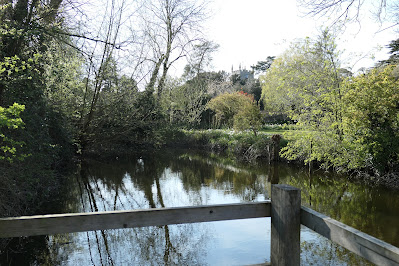 |
| The village pond, with the church in the distance |
There are several ways of looking at a place. I am surrounded by books concentrating on buildings (Pevsner), or focusing on walks (various guides), or even landscape (the marvellous Hertfordshire: a Landscape History), yet they none of them describe the totality of the experience of one short walk.
The place was Barkway, and the walk just three or four miles, a circular tour starting in the village, walking East between the grounds of a large house and a wood (Earls Wood), then following the edge of the wood around three sides and returning down a very gentle slope back to the village.
So here was a village, clearly prosperous enough to sustain a flower shop, but not sufficiently pressed for everyday needs to have a corner store. No sign that there had ever been a station.
The walk started at a recreation ground, interesting for a few features. A sign at the entrance stated the ground had been the recipient of Premier League and Football Association funding for changing rooms – a very welcome reminder that football need not all be about making more money for the top clubs, as the European Super League had tried to do. The recreation ground had adults in it – it was not a no-go area abandoned to outsiders. Finally, there was a very nice semi-circular seat in memory of someone, a lovely place to sit and to enjoy your coffee.
The highlight of the walk was not the village or the
recreation ground but the wood, about a mile to the East. I couldn’t find any
mention of the wood for anything exceptional. It was a deciduous wood, not
ancient, and with the trees planted quite far apart, which meant on the ground
there was quite a bit of vegetation: plenty of bluebells and cowslips to be
seen Every few hundred yards the wood had been partially cleared, as if for a
fire break, but then there would be a
few big trees in the clearing. No, the purpose of the wood was evident from the
iron steps provided at several locations, and the prominent signs saying “private
– no entry”. This was a wood for shooting game. For the walker, the enjoyment
of the wood from the edge or from the middle was pretty much equal, so I couldn’t
complain. In fact probably the best view of the wood was along the edge, where you
could observe the trails made by animals (badgers? deer?) in and out of the
trees. The whole wood, indeed the whole walk, had some very light gradients,
which gave a pleasant aspect to the walk. It was a circular walk, but the path
changed direction every few hundred yards, which meant for the most part you
couldn’t see what was coming next.
 |
| Barkway, main street: the historic centre |
After the wood, back to a new development at the southern end of Barkway, where the footpath was hemmed in by tall fences on either side making sure the new houses could not be viewed by any of the walkers. Then back to the main street, the school, some almshouses, a village pond, and to the start.
How could you sum up such a village? A great walk, a lovely
wood, a recreation ground. No shops. Expensive cars. Land organised around
shooting. Which of these represented Barkway? A bit of all of these?





